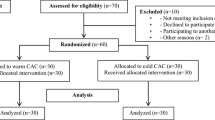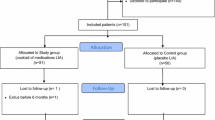Abstract
The aim of this study was to evaluate the analgesic effect of an external cooling system with or without the combined effect of intra-articularly administered bupivacaine/morphine after arthroscopic anterior cruciate ligament (ACL) reconstruction. Fifty patients with isolated ACL insufficiency operated on under general anaesthesia were randomized to three different postoperative treatment groups. Group I was treated with the cooling system during the first 24 h after surgery and an intraarticular injection of 20 ml of physiological saline given at the completion of surgery; in group II, the cooling system was combined with an intra-articular injection of 20 ml bupivacaine 3.75 mg/ml and 1 mg of morphine at the end of the operation; while group III (placebo group) received an intra-articular injection of 20 ml of physiological saline at the completion of surgery. Pain was assessed using a visual analogue scale (VAS) at 1, 2, 4, 6, 24 and 48 h postoperatively. Supplementary analgesic requirements were registered. In group I 80% (16/20) and in group II 90% (18/20) of the patients were satisfied with the postoperative pain control regimen (NS). This was significantly better than in group III, where 30% (3/10) were satisfied. The pain scores were significantly lower in the two treatment groups compared with the placebo group during the entire postoperative period. The pain score was significantly lower in group II than in group I at 24 and 48 h after surgery. The supplementary analgesic requirements were also lower in the two treatment groups compared with the placebo group. No complications due to the use of the cooling system or the intra-articular injections of bupivacaine/morphine were observed. The external cooling system used in this study provides an effective method of obtaining pain relief after arthroscopic surgery. The combination with an intra-articular injection of morphine and bupivacaine results in a slightly greater analgesic effect than the cooling system alone.
Similar content being viewed by others
References
Abraham W (1974) Heat versus cold therapy for the treatment of muscle injuries. Athletic Training 9: 177–182
Abrahamson D (1965) The physiologic basis for the use of physical agents in peripheral vascular disorders. Arch Phys Med Rehabil 9: 216–244
Barthó L, Stein C, Herz A (1990) Involvement of capsaicin-sensitive neurons in hyperalgesia and enhanced opioid antinociception in inflammation. Naunyn Schmiedebergs Arch Pharmacol 342: 666–670
Bassett F, Kirkpatrick J, Engelhardt D, Malone T (1992) Cryotherapy induced nerve injury. Am J Sports Med 20: 516–518
Boden BP, Fassler S, Cooper S, Marchetto PA, Moyer RA (1994) Analgesic effect of intra-articular morphine, bupivacaine and morphine/bupivacaine after arthroscopic knee surgery. Arthroscopy 10: 104–107
Buckley F, Simpson B (1980) Acute traumatic and postoperative pain management. In: Cousins MJ, Bridenbaugh PO (eds) Neural blockade, Lippincott, Philadelphia, pp 587–613
Chirawa SS, MacLeod BA, Day B (1989) Intra-articular bupivacaine (Marcaine) after arthroscopic meniscectomy: a randomized double-blind controlled study. Arthroscopy 5: 333–335
Cohn BT, Draeger RI, Jackson RW (1989) The effects of cold therapy in the postoperative management of pain in patients undergoing anterior cruciate ligament reconstruction. Am J Sports Med 17: 344–349
Dahl JB, Kehet H (1991) Non-steroidal anti-inflammatory drugs: rationale for use in severe post-operative pain. Br J Anaesth 66: 703–705
Daniel DM, Stoen ML, Arendt DL (1994) The effect of cold therapy on pain, swelling, and range of motion after anterior cruciate ligament reconstructive surgery. Arthroscopy 10: 530–533
Dean B, Williams F, King J, Goddard M (1994) Pain rehabilitation IV. Therapeutic option in pain management. Arch Phys Med Rehabil 75: 21–30
Debruvne D, Moulin M, Carmes C, Beguin J, Locker B (1985) Monitoring serum bupivacaine levels during arthroscopy. J Clin Pharmacol 27: 733–735
Debruvne D, Moulin M, Thomassin C (1985) Prilocaine in arthroscopy: clinical pharmacokinetics and rational use. Clin Pharmacol Ther 38: 213–223
Drez D, Faust D, Evans P (1981) Cryotherapy and nerve palsy. Am J Sports Med 9: 256–257
Editorial (1990) A response to pain. Lancet 336: 870
Edwards DJ, Rimmer M, Keene GCR (1996) The use of cold therapy in the postoperative management of patients undergoing anterior cruciate ligment reconstruction. Am J Sports Med 24: 193–195
Ekblom A, Westman L, Söderlund A, Valentin A, Eriksson E (1993) Is intraarticular pethidine an althroscopy? A double-blind study comparing prilocaine with pethidine. Knee Surg Sports Traumatol Arthroscopy 1: 189–194
Ferreira SH, Nakamura M (1979) Prostaglandin hyperalgesia: the peripheral analgesic activity of morphine, enkephalins and opioid antagonists. Prostaglandins 18: 191–200
Fulkerson J, Folick MA (1986) Analgesia following arthroscopic surgery: comparison of diflunisal and acetaminophen with codeine. Arthroscopy 2: 189–198
Gerber H, Censier H, Gatcher A, Arsuffi A, Romppainen J (1985) Intra-articular absorption of bupivacaine during arthroscopy. Anesthesiology 64: 217
Grana W (1994) Cold modalities. In: DeLee J, Drez D (eds) Orthopaedic sports medicine: Principles and practice, Saunders, Philadelphia, pp 203–207
Healy W, Seidman J, Pfeifer B, Brown D (1994) Cold compressive dressing after total knee arthroplasty. Clin Orthop 299: 143–146
Ho SSW, Illgen RL, Meyer RW, (1995) Comparison of various icing times in decreasing bone metabolism and blood flow in the knee. Am J Sports Med 23: 74–76
Hocutt JE (1981) Cryotherapy. Am Fam Phys 23: 141–144
Hocutt JE, Jaffe R, Rylander CR, Beebe JK (1982) Cryotherapy for postoperative pain relief following knee arthroplasty. J Arthroplasty 9: 285–290
Joris J, Dubner R, Hargraves K (1987) Opioid analgesia at peripheral sites: a target for opiods released during stress and inflammation? Anesth Analg 66: 1277–1281
Karlsson J, Rydgren B, Eriksson B, Järvholm U, Lundin O, Swärd L, Hedner T (1995) Postoperative analgesic effects of intra-articular bupivacaine and morphine after arthroscopic cruciate ligament surgery. Knee Surg Sports Traumatol. Arthroscopy 3: 55–59
Keading CC, Hill JA, Katz J, Benson L (1990) Bupivacaine use after knee arthroscopy: pharmacokinetics and pain control study. Arthroscopy 6: 33–39
Khoury GF, Stein C, Garland DE (1990) Intraarticular morphine for pain after knee arthroscopy (letter). Lancet 336: 871
Khoury GF, Chen ACN, Garland DE, Stein C (1992) Intraarticular morphine, bupivacaine and morphine/bupivacaine for pain control after knee videoarthroscopy. Anesthesiology 77: 263–266
Lawrence AJ, Joshi GP, Michalkiewicz WP, Blunnie WP, Moriarty DC (1992) Evidence for analgesia mediated by peripheral opioid receptors in inflamed synovial tissue. Eur J Clin Pharmacol 43: 351–355
Levy A, Marmar E (1993) The role of cold compression dressings in the postoperative treatment of total knee arthroplasty. Clin Orthop 297: 174–178
Lievens P, Leduc A (1984) Cryotherapy and sports. Int J Sports Med 5: 37–39
McLean D (1989) The use of cold and superficial heat in the treatment of soft tissue injuries. Br J Sports Med 23: 53–54
McMaster WC, Liddle S (1980) Cryotherapy influence on posttraumatic limb edema. Clin Orthop 150: 283–287
Meeusen R, Lievens P (1986) The use of cryotherapy in sports injuries. Sports Med 3: 398–414
Ngo I, Hamilton W, Wilhern W, Andree R (1985) Local anesthesia with sedation for arthroscopic surgery of the knee. A report of 100 consecutive cases. Arthroscopy 1: 237–241
Nole R, Munson NML, Fulkerson JP (1985) Bupivacaine and saline effect on articular cartilage. Arthroscopy 1: 123–127
Olson JE, Stranvino VD (1972) A review of cryotherapy. Phys Ther 52: 840–853
Scheffler N, Sheitel P, Lipton M (1992) Use of CRYO-CUFF® for the control of postoperative pain and edema. J Foot Surg 31: 141–148
Scott J, Huskison EC (1976) Graphic presentation of pain. Pain 2: 175–184
Snedeker J, Recine V, MacCartee C (1974) Cryotherapy and the athletic injury. Athletic J 55: 16–18
Speer KP, Warren RF, Horowitz L (1996) The efficacy of cryotherapy in the postoperative shoulder. J Shoulder Elbow Surg 5: 62–68
Stein C, Millan MU, Shippenberg TS, Herz A (1988) Peripheral effect of fenantyl upon nociception in inflamed tissue of the rat. Neurosci Lett 84: 225–228
Stein C, Millan MJ, Shippenberg TS, Peter K, Herz A (1989) Peripheral opioid receptors mediating antinociception in inflammation. Evidence of Mu, Delta and Kappa receptors. J Pharmacol Exp Ther 248: 1269–1278
Stein C, Gramsch C, Herz A (1990) Intrinsic mechanisms of antinociception in inflammation: local opioid receptors and beta-endorphin. J Neurosci 10: 1292–1298
Stein C, Hassan AHS, Przewlocki R, Gramsch C, Peter K, Herz A (1990) Opioids from immunocytes interact with receptors on sensory nerves to inhibit nociception in inflammation. Proc Natl Acad Sci USA 87: 5935–5939
Stein C, Comisel K, Hamierl E, Yassouridis A, Lehrberger K, Herz A, Peter K (1991) Analgesic effects of intraarticular morphine after arthroscopic surgery. N Engl J Med 325: 1123–1126
Thorsson O, Lilja B, Ahlgren L, Hemdahl B, Westlin N (1985) The effect of local cold application on intramuscular blood flow at rest and after running. Med Sci Sports Exerc 17: 710–713
Author information
Authors and Affiliations
Rights and permissions
About this article
Cite this article
Brandsson, S., Rydgren, B., Hedner, T. et al. Postoperative analgesic effects of an external cooling system and intra-articular bupivacaine/morphine after arthroscopic cruciate ligament surgery. Knee Surg, Sports traumatol, Arthroscopy 4, 200–205 (1996). https://doi.org/10.1007/BF01567963
Received:
Accepted:
Issue Date:
DOI: https://doi.org/10.1007/BF01567963




